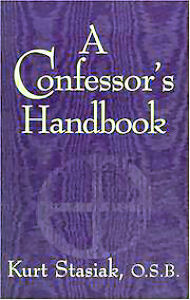
|
Posted July 10, 2009
Book: A Confessor’s Handbook Author: Kurt Stasiak, O.S.B. Paulist Press. New York. 1999. Pp. 153 An Excerpt from the Jacket:
An Excerpt from the Book: Answer the fundamental question: Why is this penitent here? When a penitent enters the confessional, he brings with him his religious upbringing and his previous experiences with the sacrament (and with his confessors). How he has understood and experienced sin and grace in his life; how he thinks of God; how he is accustomed to approaching a priest and the sacrament: these factors shape his confession, for better or worse. Does the penitent think of God as a judge — or as the Father of Mercies? Does she see her confessor as a “channel” directing her plea for forgiveness upward and then pulling down God’s pardon from above? Or in her eyes are we a minister in the true sense of the word: a representative of the Church and an instrument and symbol of the grace of God? Does her examination of conscience and subsequent confession resemble a lengthy lamentation of legal violations? Or is her preparation for and celebration of the sacrament a time of accountability for her: a time when, with the help of God’s grace, she renews her responsibilities as Christian, wife, and mother? Why is this person here? Different people approach the sacrament for different reasons. The man who approaches the confessional with “God the judge” peering over his shoulder may be preoccupied with avoiding the fires of hell. The woman who describes her life as tedious and uninspiring may feel that God is more distant than present — representing a quite different perspective for her, and suggesting a different way of proceeding for us. The examples are plenty, and sometimes the first words of a penitent will give us a good indication of “why this person is here” and what this confession is about. The parishioner who begins with the comment, “I just can’t seem to get my life together,” is in a far different place spiritually and psychologically than the one who begins by saying, “I think I’ve already confessed this, but I just want to make sure.” So, too, the gentleman of fifty-five and the young adult of twenty-five may confess what are, objectively, the same sins. But while the first may be preoccupied with the future price he will pay for his sin, the latter may be concerned more about his lack of response to God’s grace (or vice versa, of course). Why is this person here? To the extent we are able to answer that question, we will understand better what this person needs to be freed from. We will be better able to respond to him as well as absolving him of his sins. Table of Contents: I. The sacramental dialogue between priest and penitent: basic principles 1. An encounter with Christ, his church, and his minister 2. The words of the penitent 3. The words of Christ and his church 4. The words of the priest II. Suggestions for practice: some things to consider 1. Answer the fundamental question: why is this penitent here? 2. Establish the focus of your remarks. 3. Use clear, simple language 4. Give a penance that will “work” 5. Consider asking the penitent “why”? 6. Know the occasion and take advantage of it 7. Memorize the formula for sacramental absolution 8. Be hospitable 9. Know the Code — and the policies of your diocese 10. Prepare to celebrate the sacrament and “debrief” afterwards III. Suggestions for practice: some things to avoid 1. Do not accuse; do not insult 2. Do not draw quick conclusions 3. Do not get lost in what you are saying 4. Do not neglect to say what must be said 5. Do not complicate or “extend” the confession for the penitent 6. Do not “reconfigure” the penitent’s confession — or the penitent’s conscience 7. Do not make the penitent’s confession your confession 8. Do not make the penitent’s confession your confession: a second version 9. Do not minimize or trivialize the penitent’s confession. IV. Special situations, special people 1. Children 2. The scrupulous penitent 3. The penitent who is “present in body” but absent in spirit 4. The penitent in need of counseling or psychotherapy 5. “This isn’t a sin, but “ 6. Frequent devotional confessions 7. The penitent returning after a long absence 8. The penitent who is a brother priest. |
|
